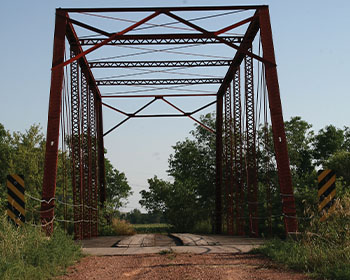NDLTAP
UGPTI Helps Local Agencies with a Focus on Bridges
Posted: Jun 15, 2022
 Thousands of bridges are scattered across North Dakota, ranging from the mile-long Four Bears Bridge to many that are so small and old that they don't show up in state, county, tribal, or township records.
Thousands of bridges are scattered across North Dakota, ranging from the mile-long Four Bears Bridge to many that are so small and old that they don't show up in state, county, tribal, or township records.
"Bridges are often bottlenecks to mobility and efficiency and they're also where numerous crashes and fatalities occur," noted Dale Heglund of the Upper Great Plains Transportation Institute (UGPTI) at NDSU. That's why UGPTI is working with local governments and the North Dakota Department of Transportation to improve bridge management; enhance bridge safety; share innovative bridge repair, improvement, and replacement strategies; and identify closed bridges that are candidates for removal. "The overall strategy is to make the road system safer and more efficient," Heglund said.
North Dakota has nearly 4,300 bridges on its federal, state, and local road systems according to the National Bridge Inventory maintained by the Federal Highway Administration. Those bridges are considered "major structures" spanning more than 20 feet. More than 3,100 of those are on county and city roads. One in five are "posted" with weight limits, sometimes as little as four tons. "An average emergency response or delivery truck weighs more than four tons," Heglund said. "A school bus can weigh 17 tons, a fire truck can weigh more than 19 tons, and a motor grader can weigh more than 22 tons, so those limits are a problem."
Local road systems have hundreds more smaller bridges, box culverts, and traditional culverts, which are considered "minor structures" with spans of less than 20 feet. But they are not minor in terms of safety. In Sioux County on the Standing Rock Indian Reservation, a large culvert wash-out in 2019 resulted in the death of two motorists.
"Those minor structures are critically important. We need to make them safer and find efficient ways to improve or replace them when possible," Heglund said.
Many of those small structures don't appear on county, township, or tribal records, so UGPTI specialists are working with local road managers to inventory those bridges, assess their conditions, and enter them into UGPTI's Geographic Roadway Inventory Tool (GRIT), an online road asset management tool that helps local road managers track of condition of roadways and associated structures.
"If you're not tracking the condition of these bridges, you can't manage them and you can't prioritize funding for timely repairs and maintenance," noted Kelly Bengtson, a UGPTI pavement and bridge engineer.
UGPTI's ND Local Technical Assistance Program coordinates bridge training for local agencies to teach maintenance best practices, rehabilitation, proper signing, inspection techniques, scour surveys, and other topics. An advanced course covers bridge load ratings which are complex calculations based on the size and thickness of bridge beams and other components, deflection of those components, amount of traffic, and other factors.
Bridges that are posted with weight limits create bottlenecks for farmers, oil-related companies and others who rely on the rural transportation network. That's why shoring up the nation's rural bridges has been a primary focus of the Soy Transportation Coalition which promotes a cost-effective, reliable, and competitive transportation system that serves the agriculture industry. Bengtson was among the analysts who helped the coalition compile a 2021 report, "Top 20 Innovations for Rural Bridge Replacement and Repair," which highlights innovative bridge replacement and repair concepts.
"Many of the concepts featured in the report can result in a 50% or greater cost savings for rural counties," said Jonathan Miller, a soybean farmer from Island, Kentucky, and chair of the coalition. "This can easily result in replacing a bridge for $100,000 to $150,000 compared with the prevailing method of $250,000 to $400,000. Spending our way out of a problem will rarely be successful. We also need to embrace innovative ways to save our way out of a problem."
Bengtson noted that those techniques are already being put into practice. North Dakota's County road crews are adept at using innovative techniques to rehab bridges to increase service life and carrying capacity. For example, in Bottineau County, road workers repaired a broken wooden piling using steel and concrete. At another location, they prepared pilings and shored up abutments with cables and anchors.
Remote areas of North Dakota may have closed bridges. most often found on two-track trails or very low-volume roads. They pose a significant safety risk when they are used by landowners, hunters and other local traffic. In those cases, the best approach may be to remove the bridge altogether. NDLTAP works with local agencies to identify those bridges and determine if they are eligible for an NDDOT funding program to remove those them. "When we get rid of those bridges, we get rid of a big safety risk," Heglund said.
"Bridges are critical links throughout our local roadway network." Heglund said. "Working with the NDDOT's Local Government team, UGPTI helps roadway owners understand their bridge networks, improve the safety of bridges and explore cost-effective options for repair and replacement."

